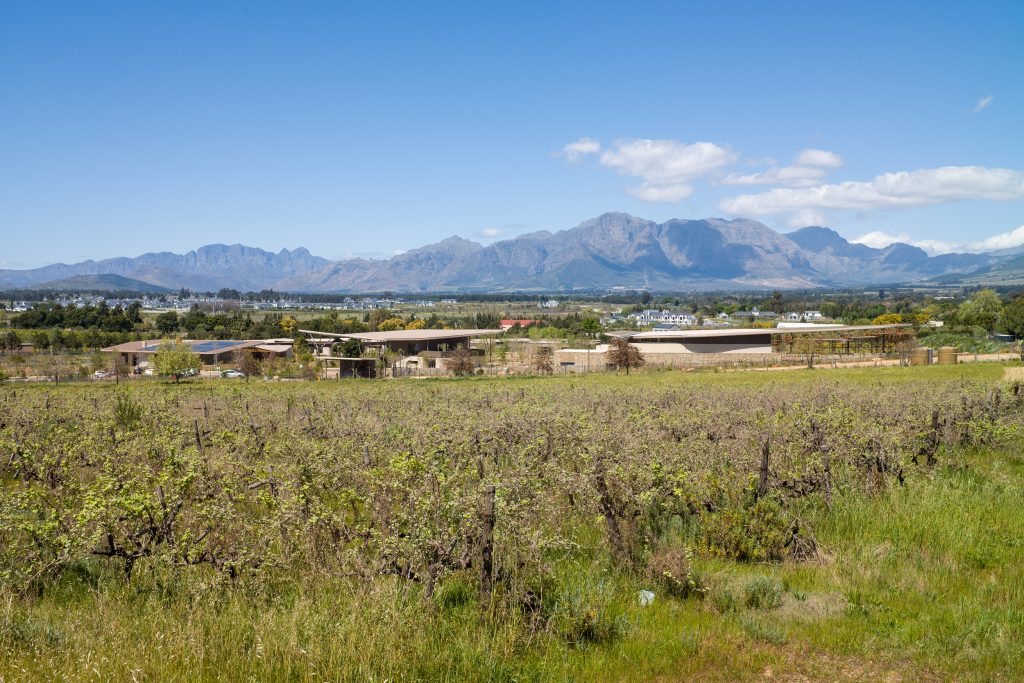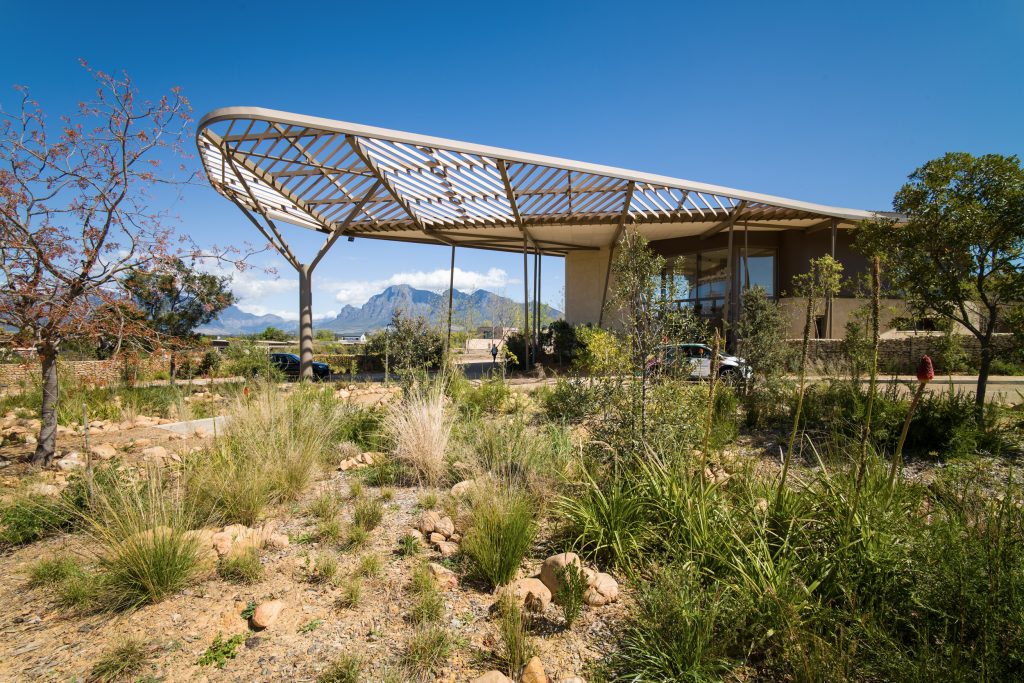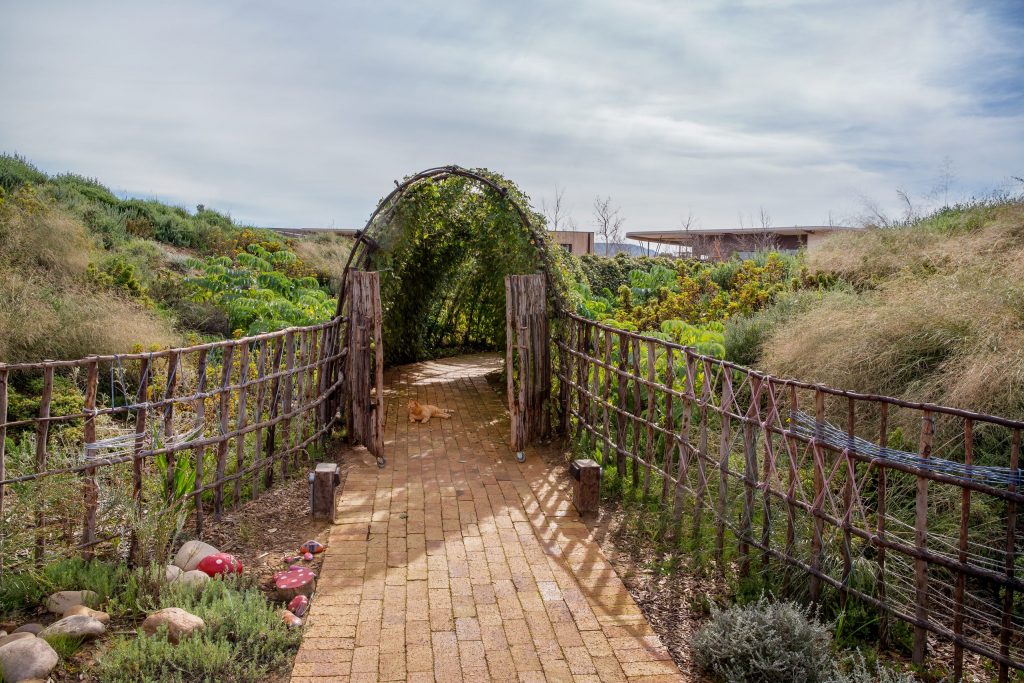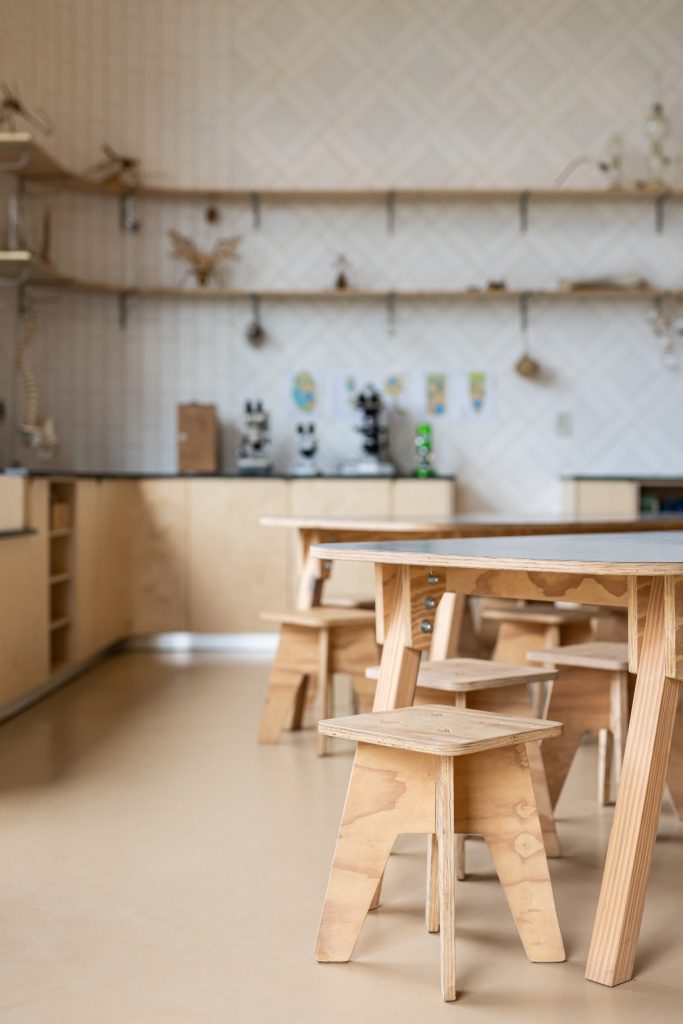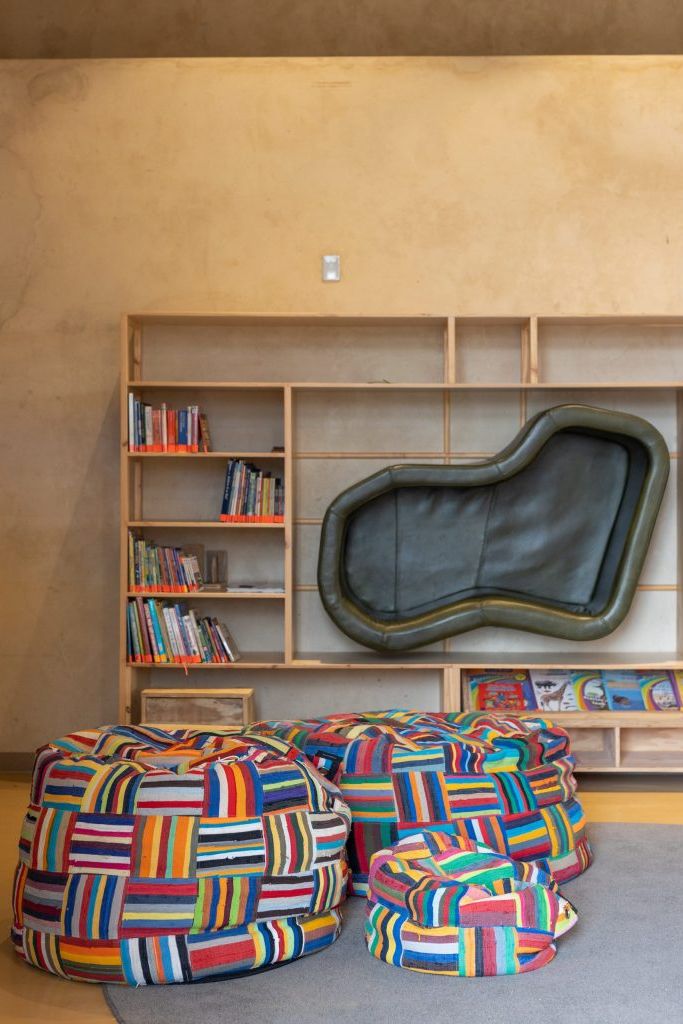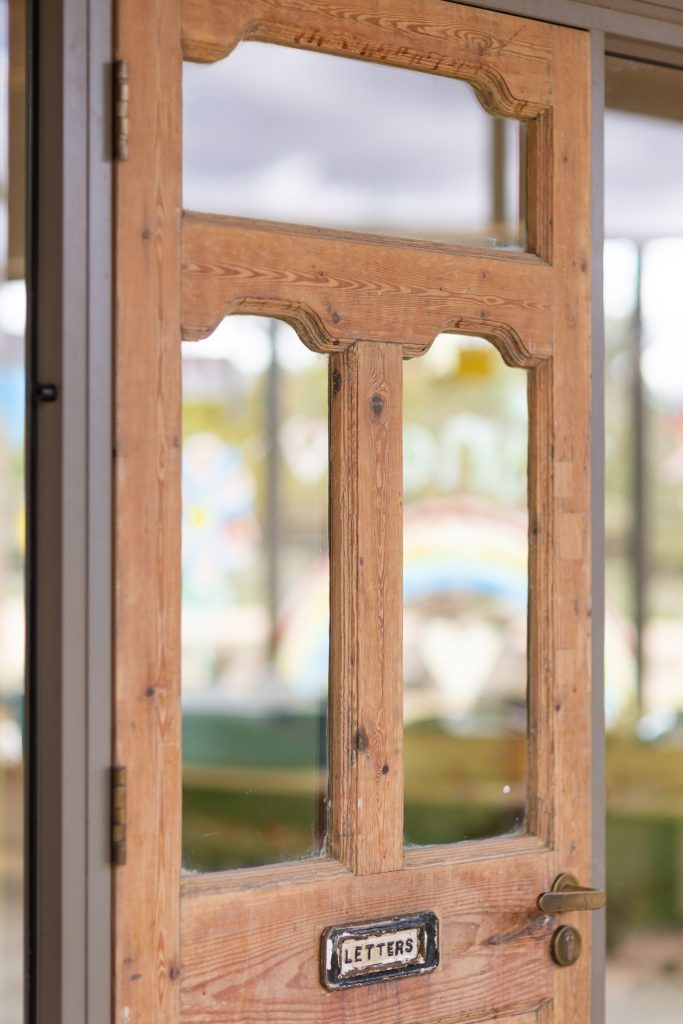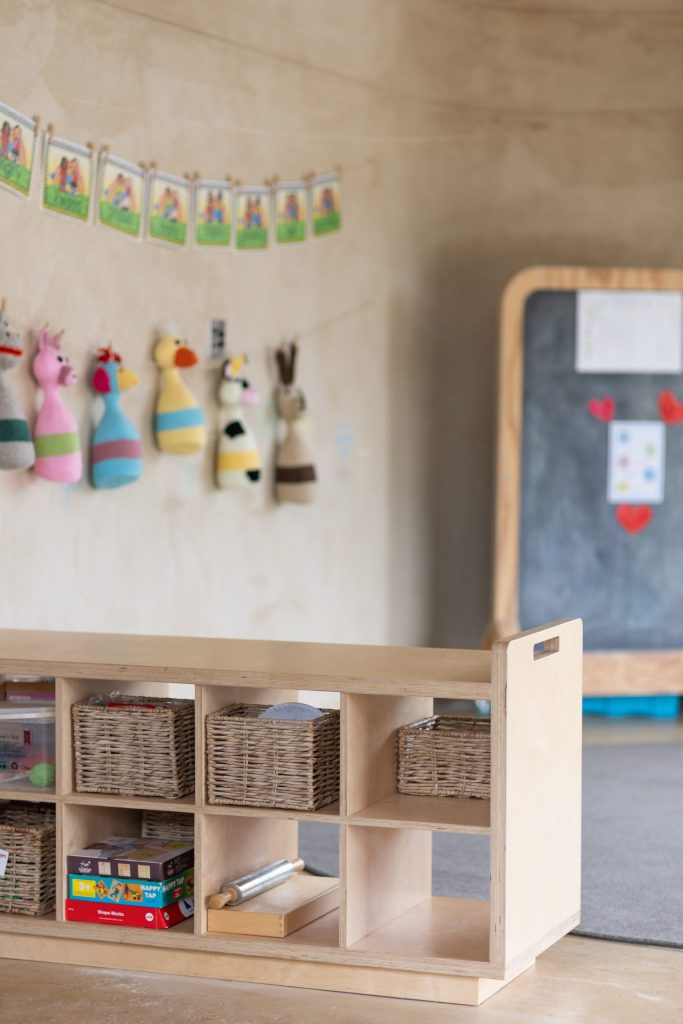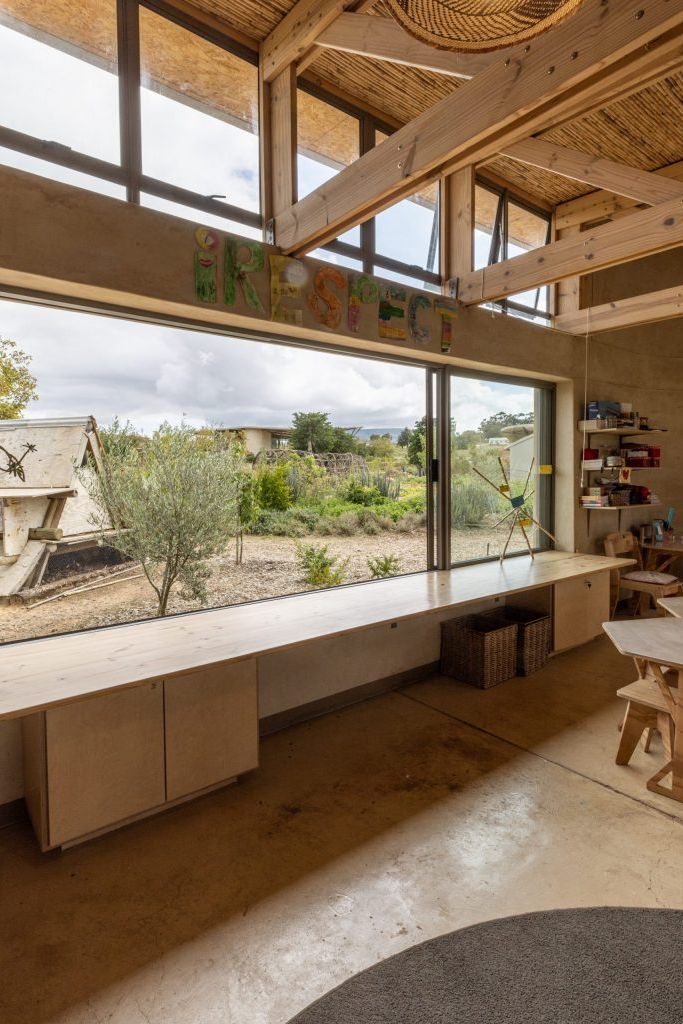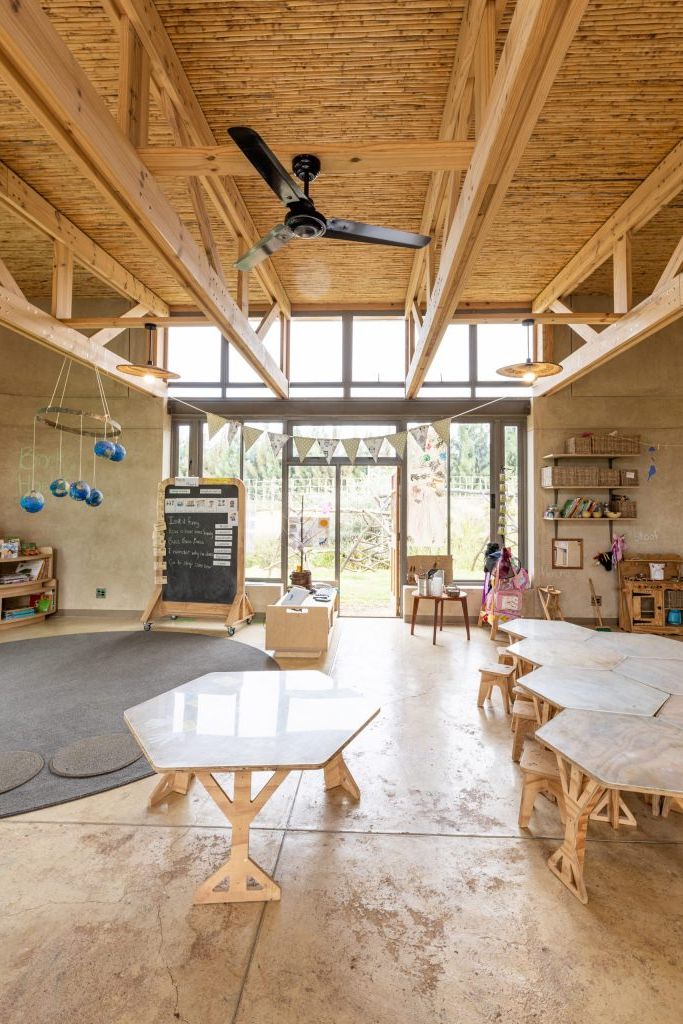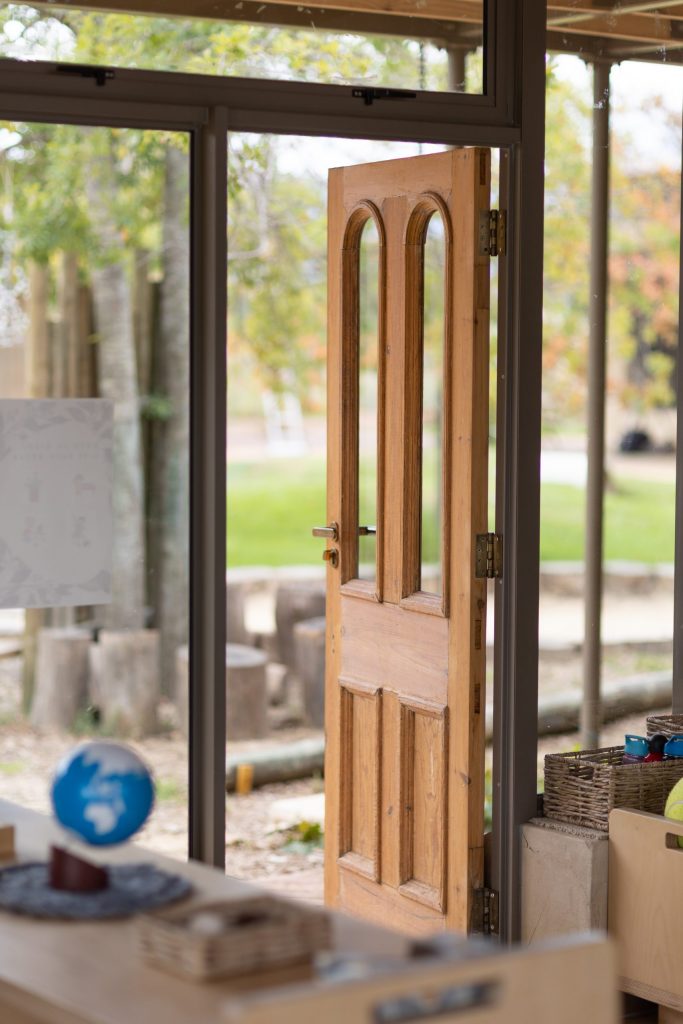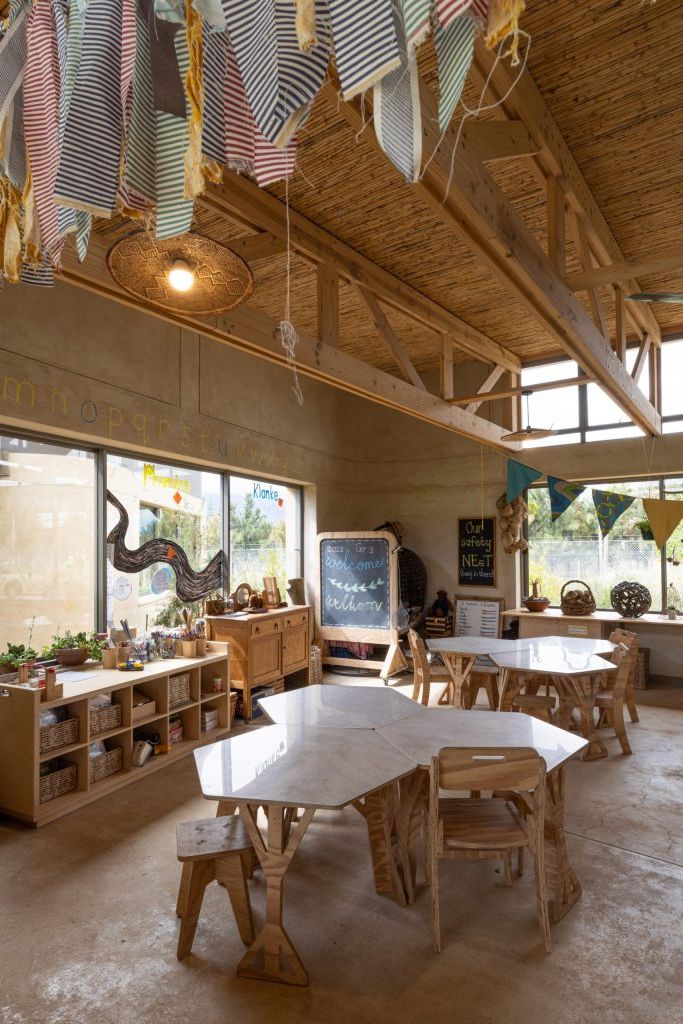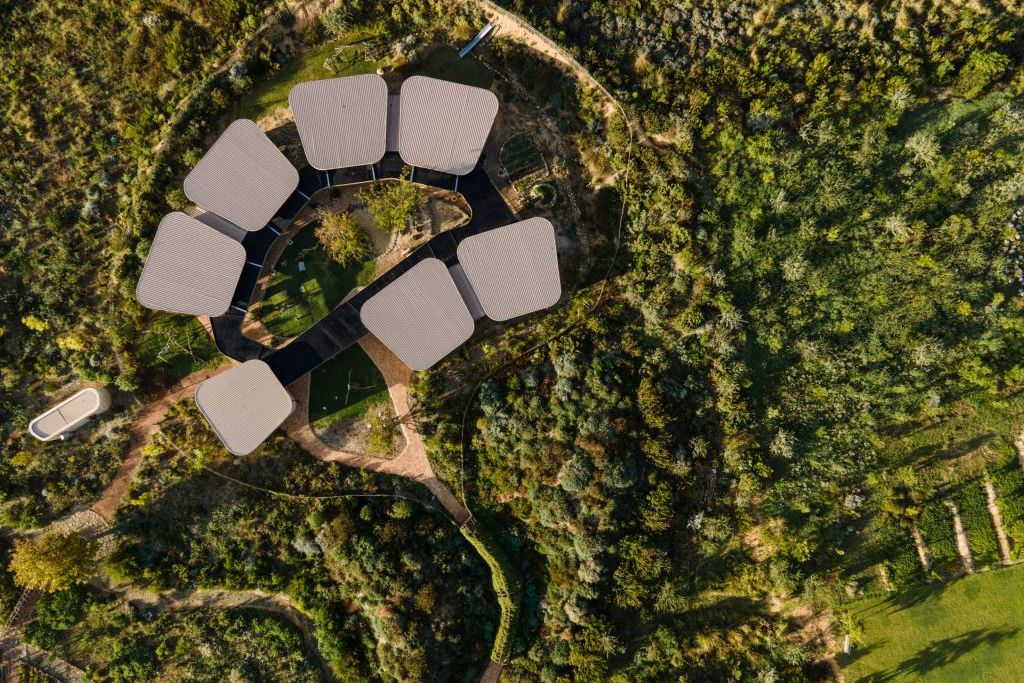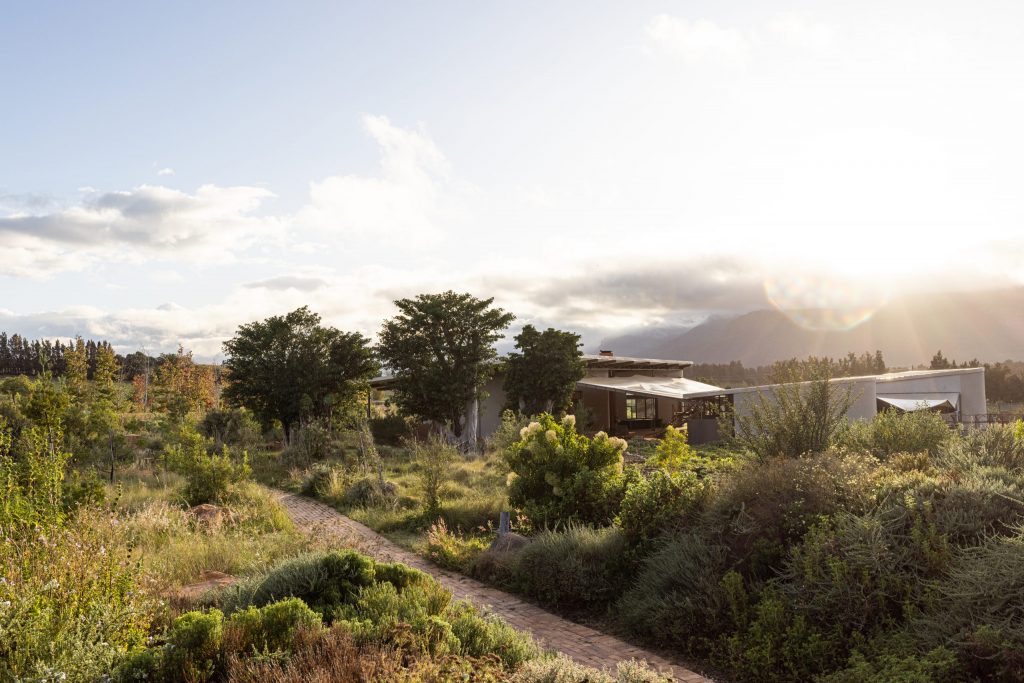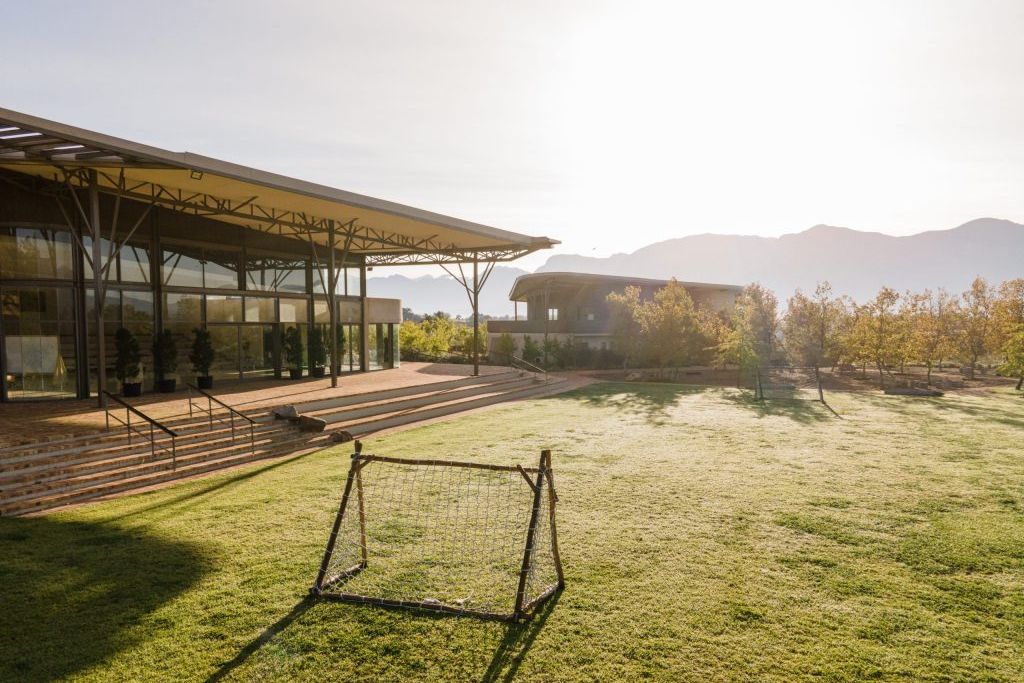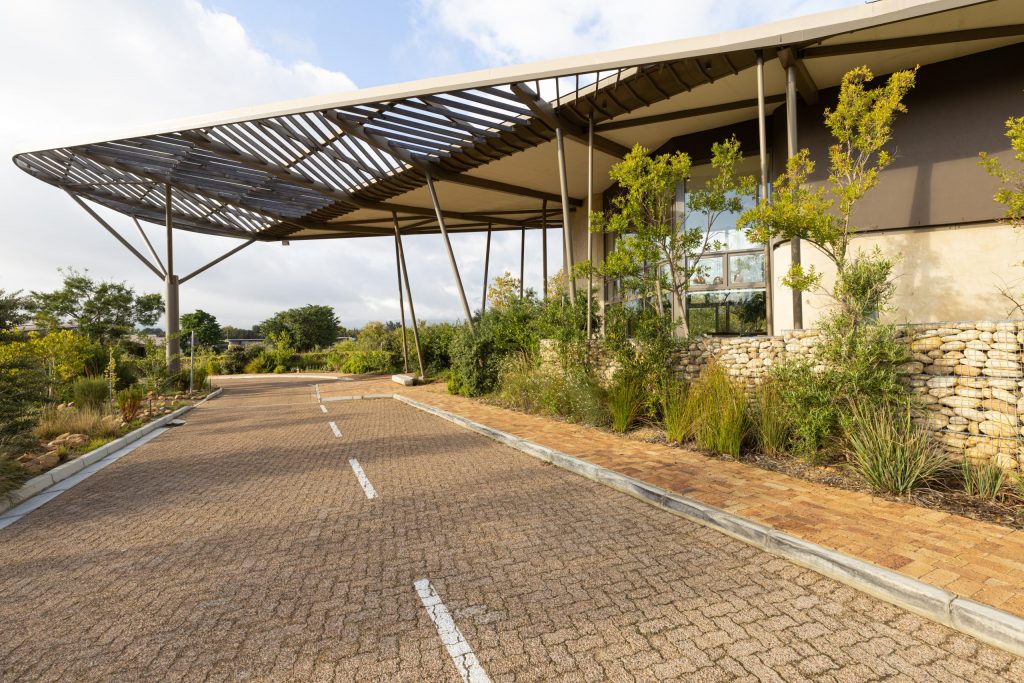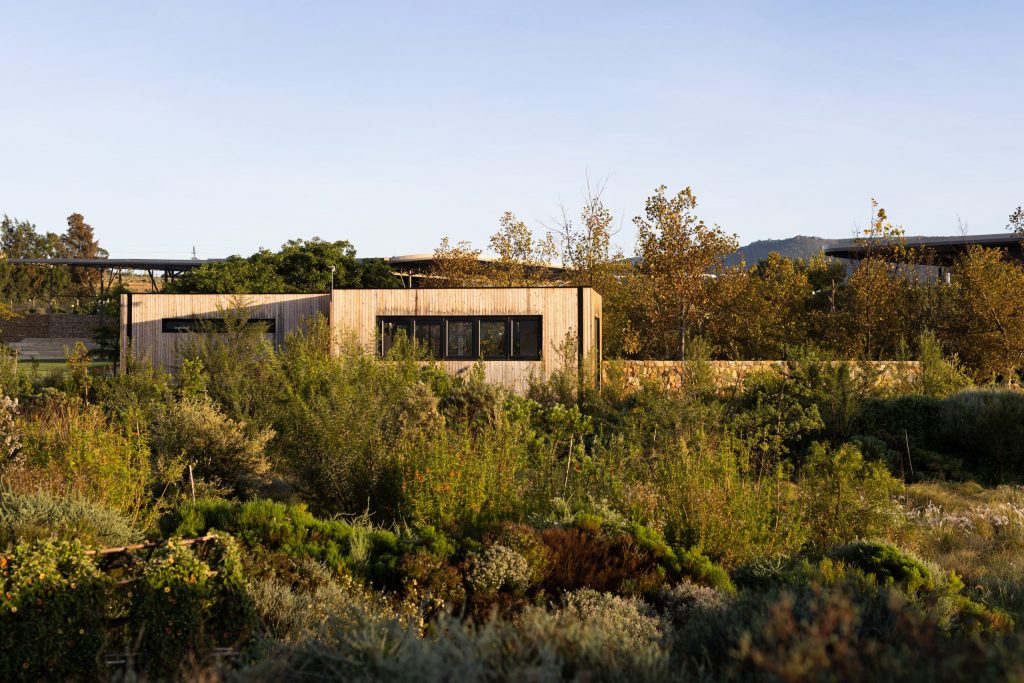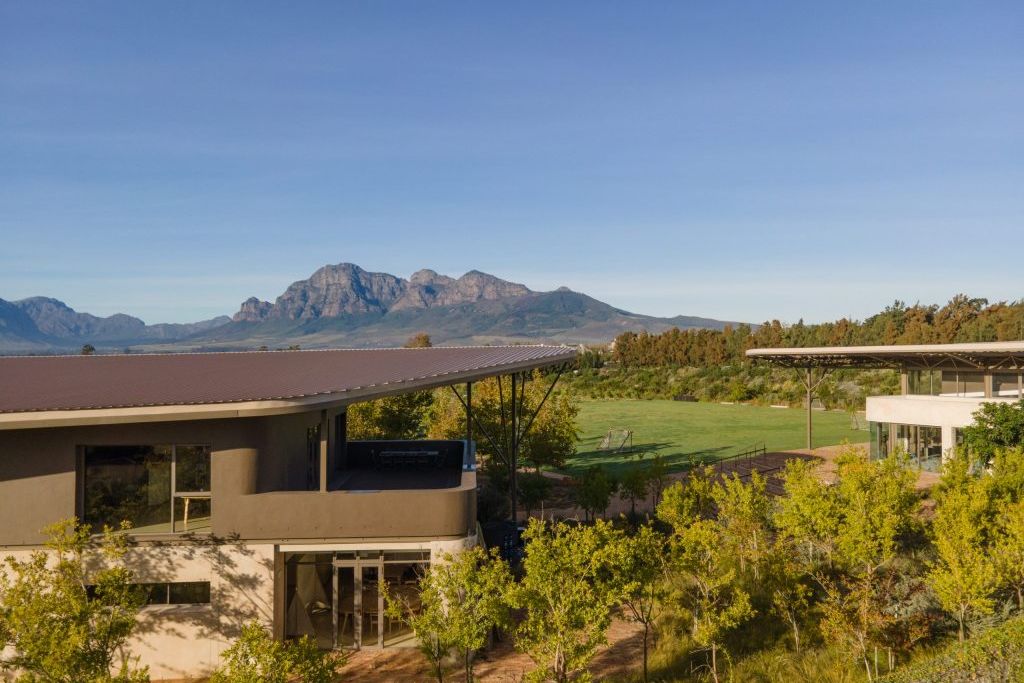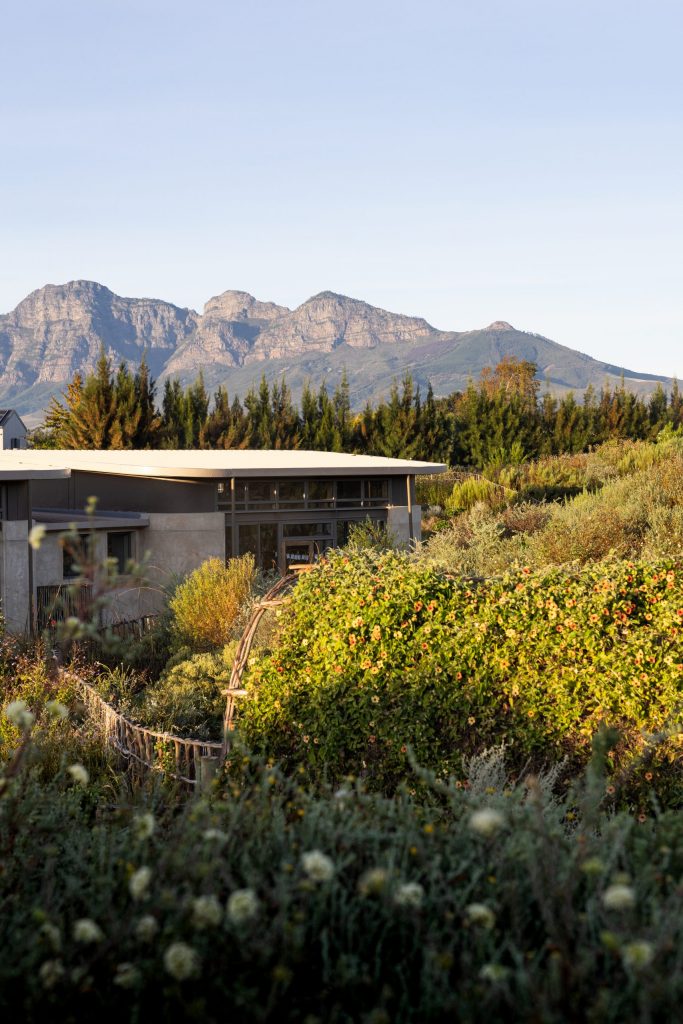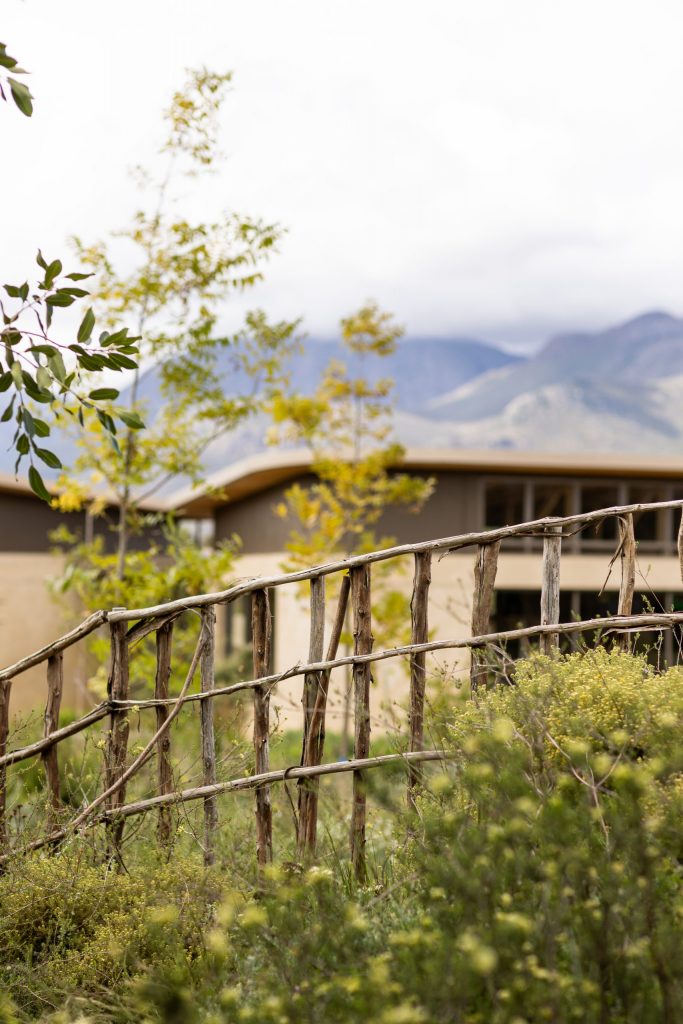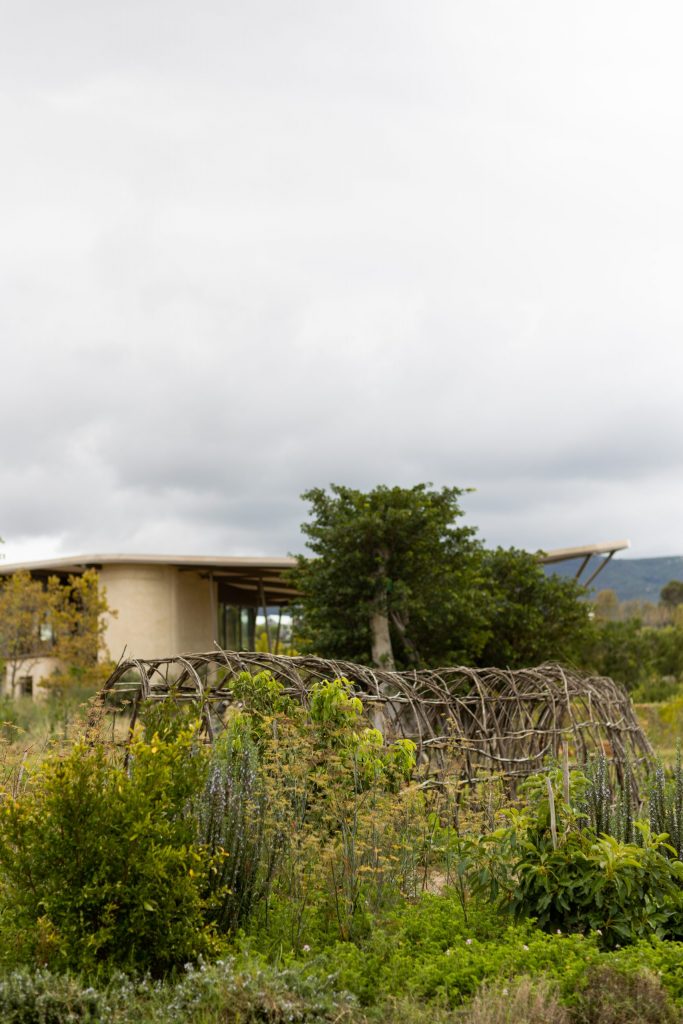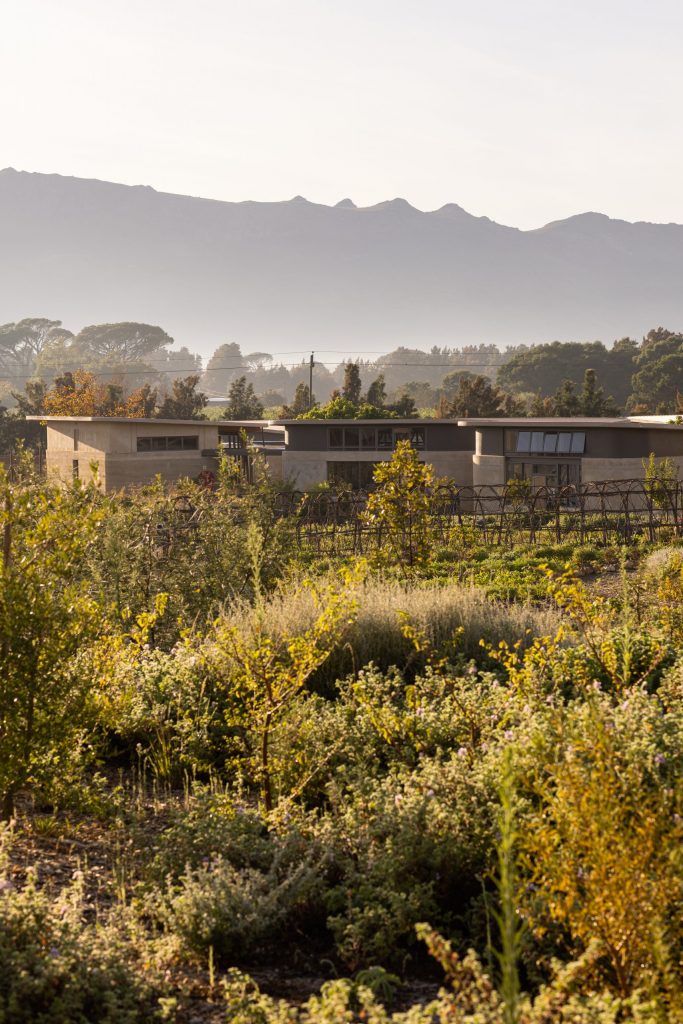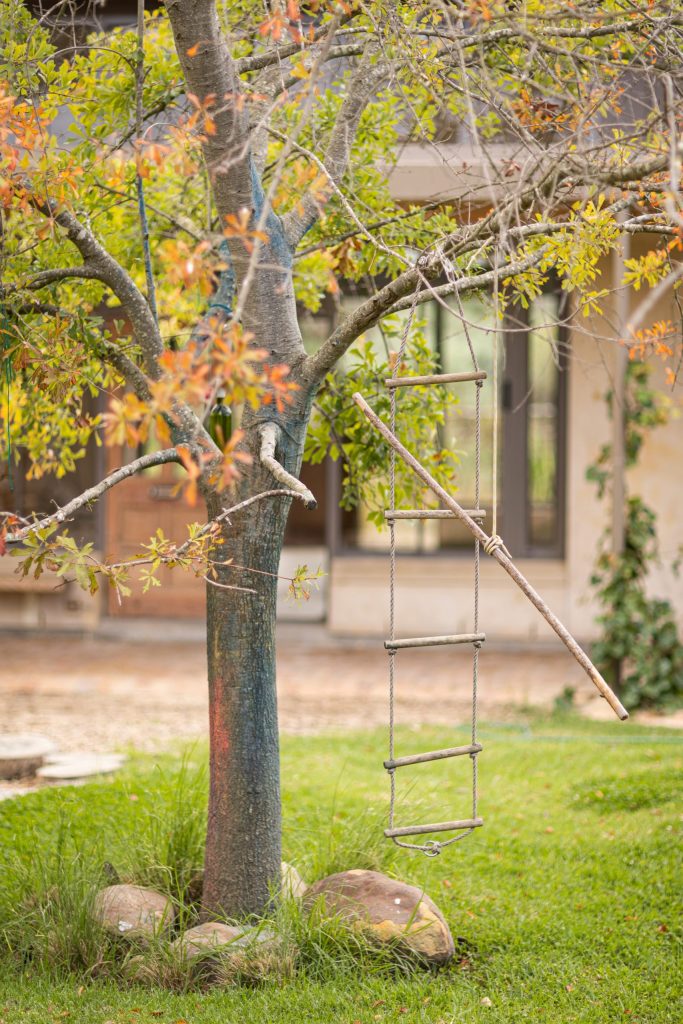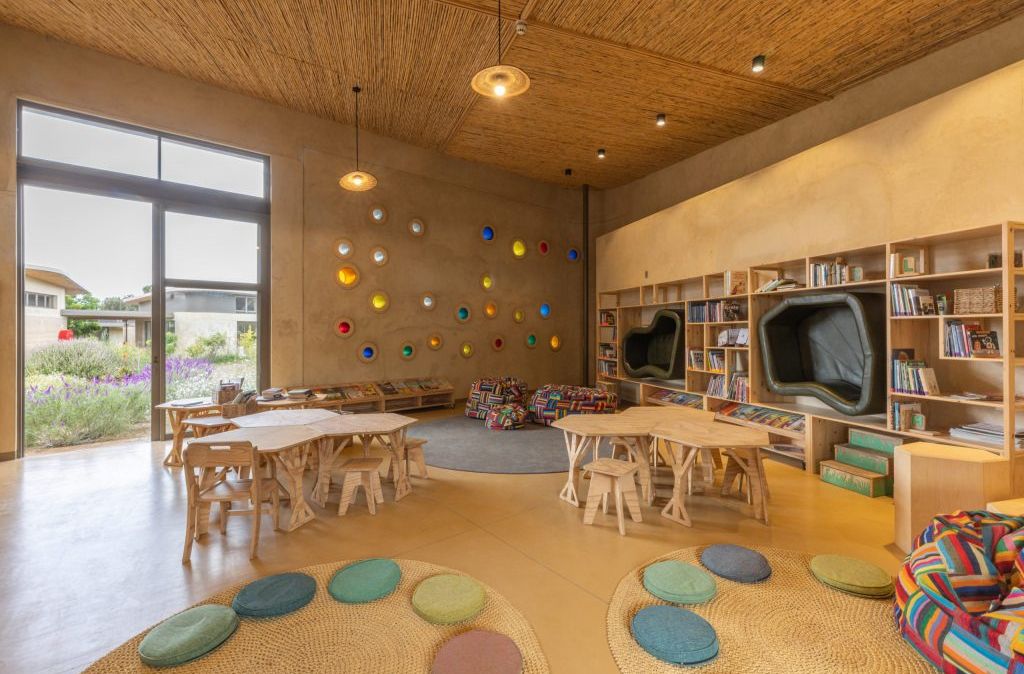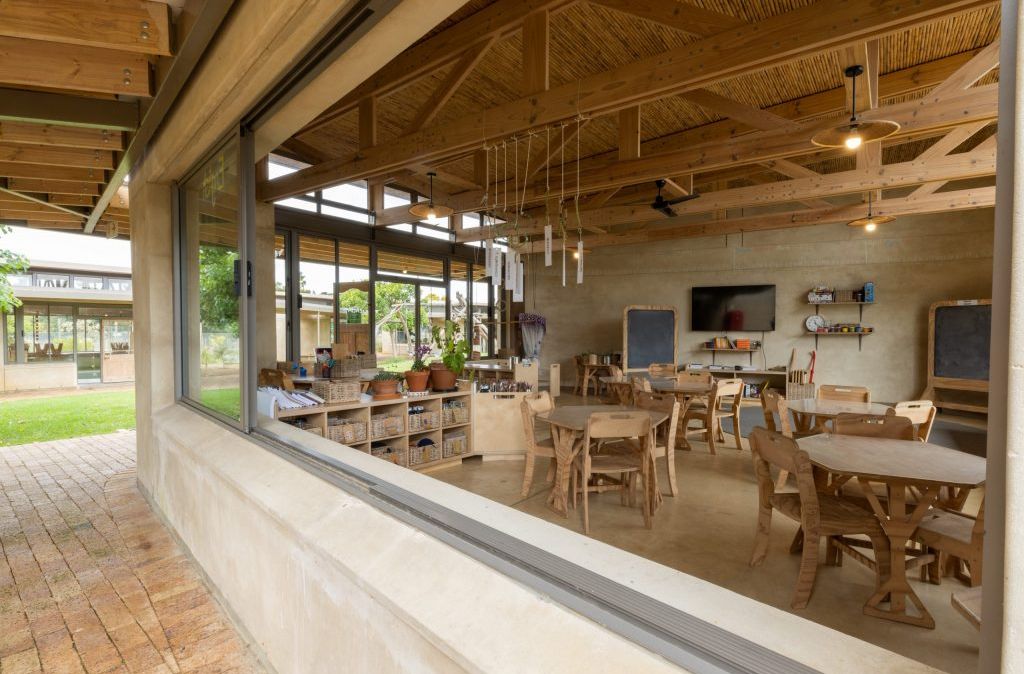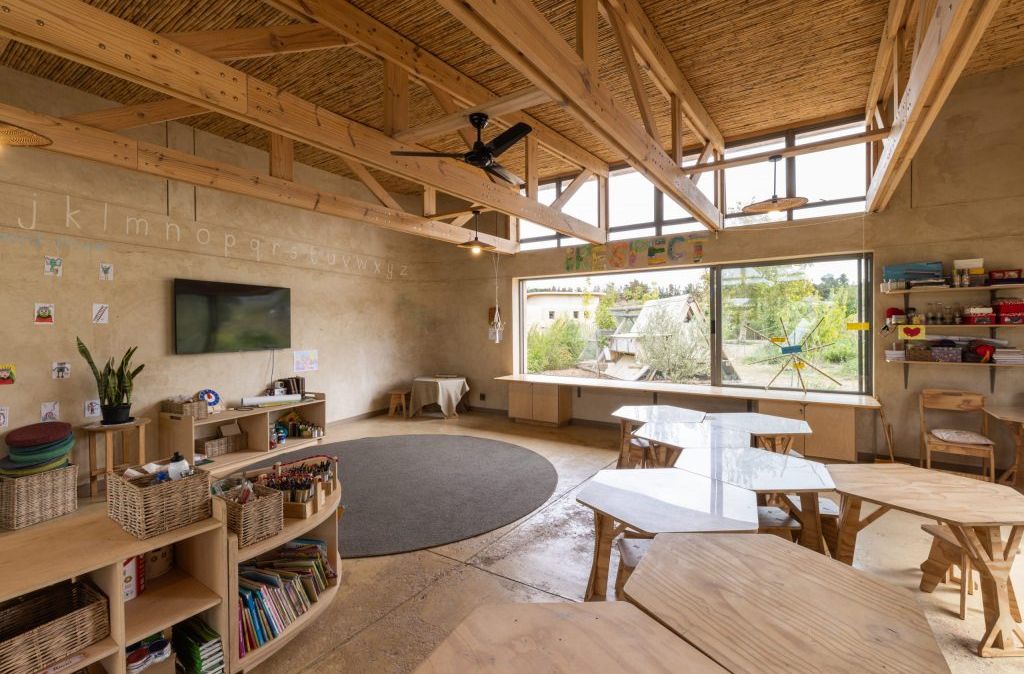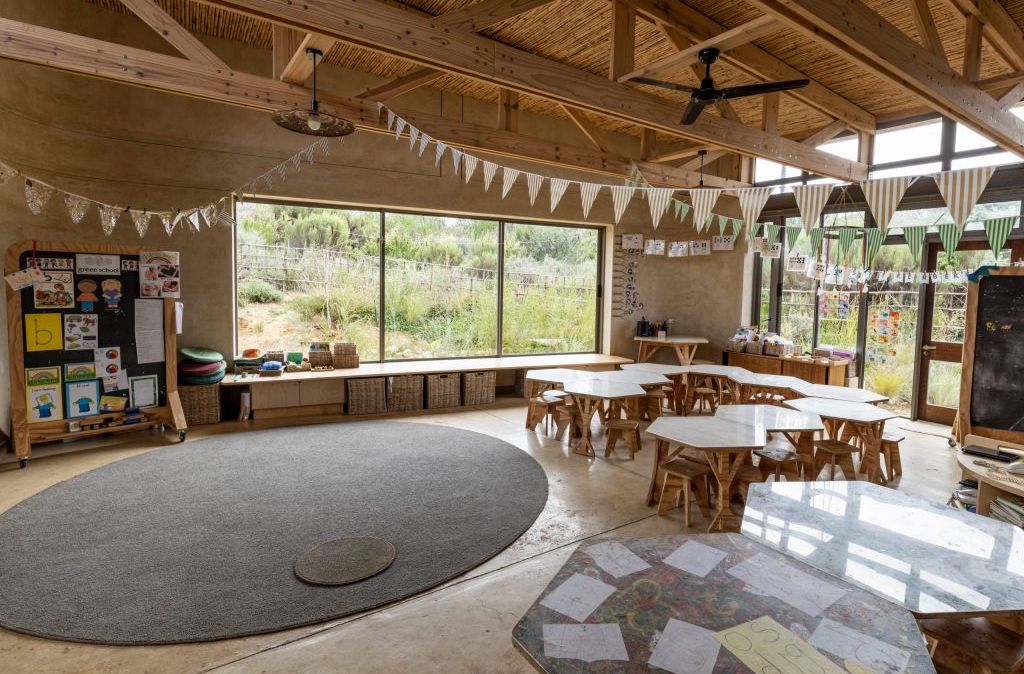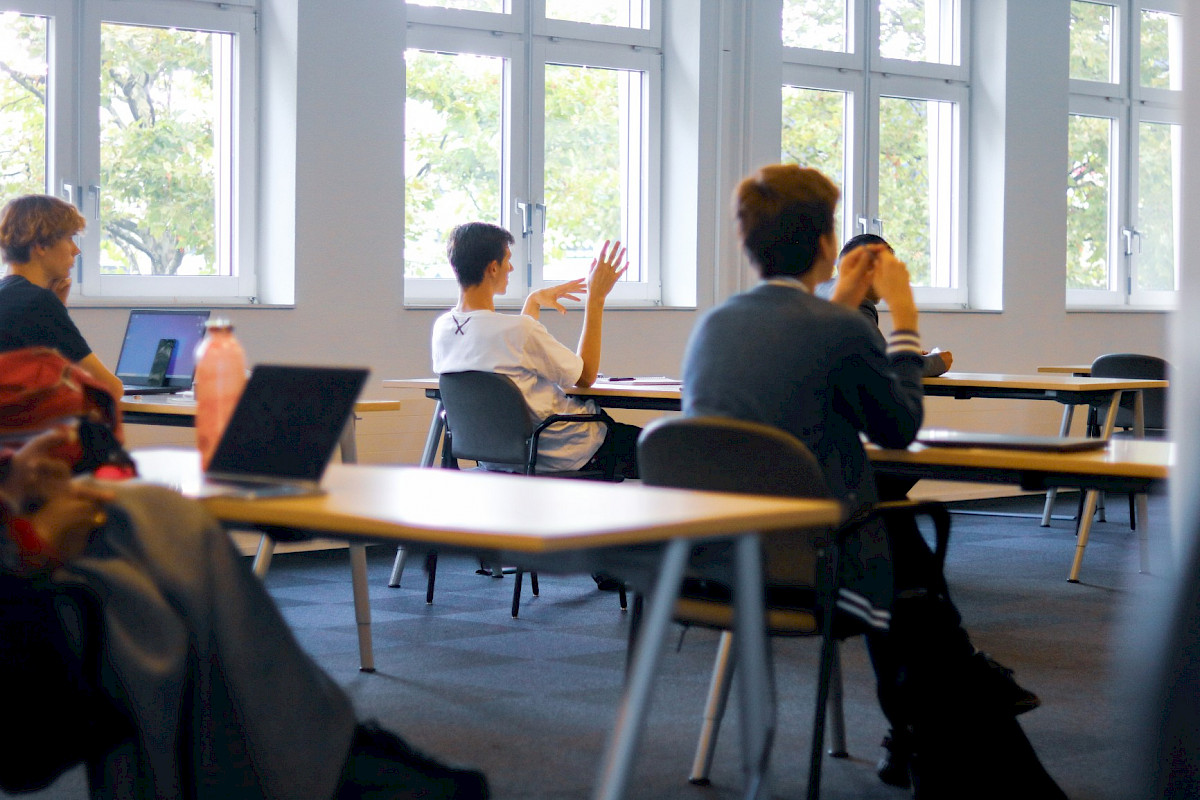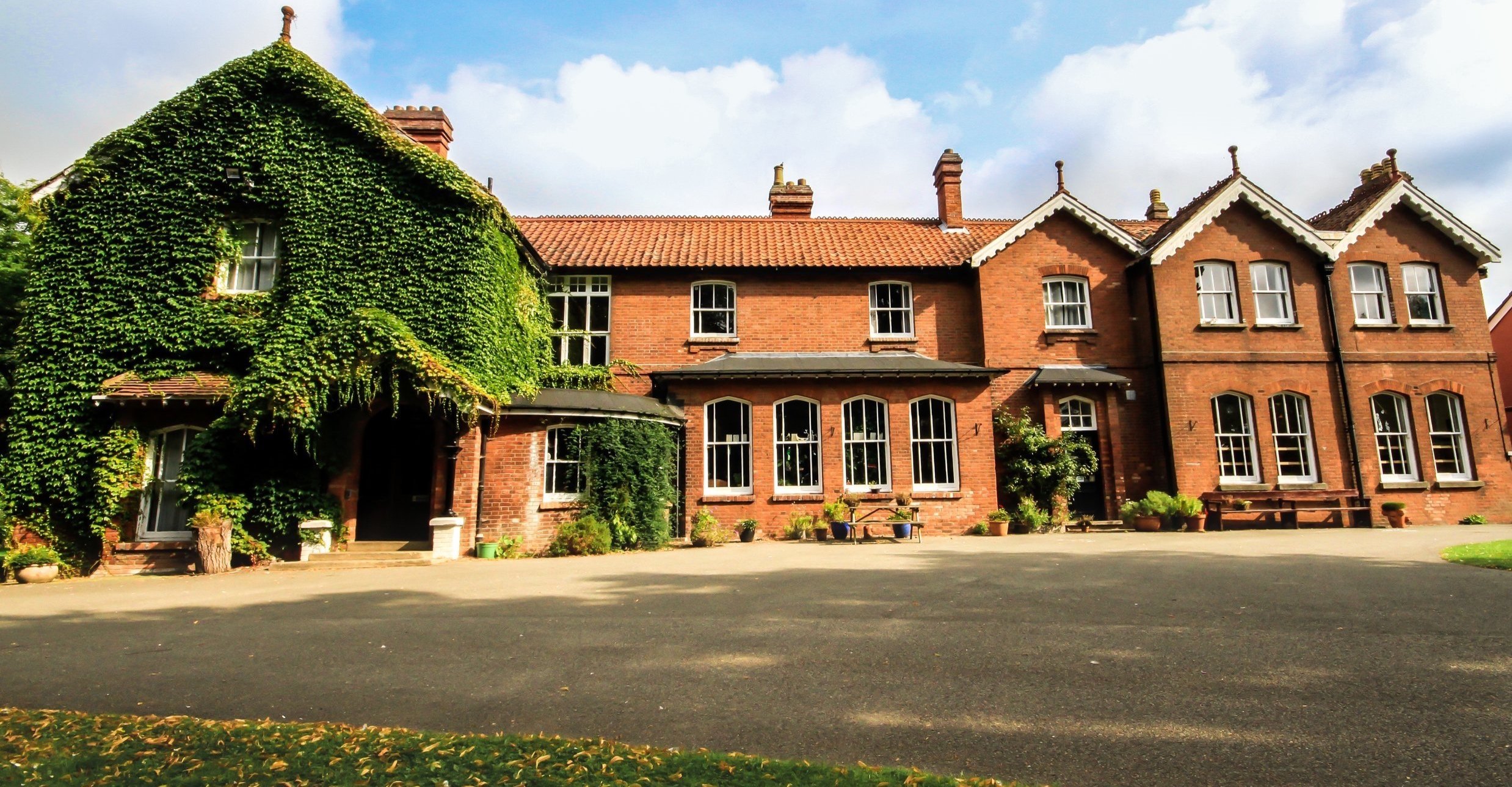Natural oxygen obtained from the atmosphere, verdant surroundings and mountains on the horizon – this is the picturesque atmosphere of one such African school environment. Does it give you a clue about something green and sustainable and something along those lines? There’s more! Add to that a school and an assembly of young, eager children learning not just about subjects but being trained in methods that pique their curiosity about nature and how to incorporate a sustainable lifestyle in sync with the plants and animals around us. This is Green School South Africa, located in Paarl, Western Cape province of the nation. The campus is surrounded by eight hectares of land in the sunny valley, infused with native flora in its gardens.

Photo: Green School South Africa
The school is a part of the global Green School movement, launched in 2008 by Green School Bali. This initiative in pedagogy was founded by entrepreneurs John and Cynthia Hardy in 2006. After two decades of running a thriving jewelry business in Bali, Indonesia, John Hardy and his wife Cynthia were yearning for a more meaningful education for their four children. When the couple realized that the existing curriculum did not align with their values, they decided to take things into their own hands.
The outcome — Green School was born — to educate children to be environmentally responsible and socially conscious global citizens. Green Schools share a commitment to creating a more sustainable future. In the face of climate disruption, Green Schools are unique in that they integrate sustainability into all aspects of the curriculum, from mathematics and science to art and music. Students learn about the environment, climate action, and social justice through hands-on experiences.
![]()
When you pass by the territory of such a school you won’t even recognize that it is a ‘school’. One wouldn’t see a bright “standing out building” with a huge sports arena or a bright landscape that grabs the attention. Instead, it looks like a garden or that of a farm with many low-rise buildings in pastel colours, perfectly integrated into the context of the school. And once you park your car there – you feel like you’ve arrived at a retreat centre with peaceful nature surroundings and friendly people with that welcoming persona.
Again, that feeling of a retreat centre becomes only stronger when you meet Alba and Andrea – the two absolutely charming, calm and friendly women – everything about them just welcomes you in their extraordinary space. And even the way the conversation started pointed out that kids’ well-being and internal confidence are at the core of the Green School’s philosophy: it’s not more inclined towards the “internal sustainability” of children living there, – here are the EdDesign Mag’s writer’s first thoughts.
How is sustainability incorporated into Green School’s school environment, building, philosophy and curricula Alba Brandt, Green School’s Co-founder and Andrea Hofmeyr, Marketing & Project Office Leader, told EdDesign Mag’s Anna Turchik.
This year Andrea Hofmeyr is the Speaker of the leading education conference & exhibition in the Middle East region: GESS Dubai (30 October – 1 November 2023). Extensive conference programme together with the exhibition provides educators access to the products and solutions that meet the needs of the modern classroom and transform the way students learn. Sustainability is one of the event’s important themes.
SUSTAINABILITY OF THE SCHOOL BUILDING
How did you come up with the idea to design and to build Green School in South Africa? What was your specific idea?
Alba Brandt: I think it always comes out of a specific need which is unavailable. Primarily, the idea was to combine sustainability and a friendly educational environment focused on every child’s individual identity. It builds on the sense that you are actually “enough”. You don’t need to prove yourself to anyone. The individual approach needs to be different from a standard school environment, including materials we use every day. Even the plates and the cutlery that we use in the dining room – it’s all handmade and has a completely different sense. One needs to feel connected to things – this is the only way to teach kids conscious consumption.
Could you please comment a few things regarding Green School’s location?
Andrea Hofmeyr: We are lucky with eight-hectares of land where we can scale up on the environment and sustainability initiatives. The iconic mountain at the backdrop of our school reminds the students, teachers and us of the giant world out there. On Fridays, the kids assemble and play sports in our grayish-beige community hall i.e. the “Sangkep” (the name comes directly from Bali Green School) made of glass, which keeps them connected with the outside world.
Our school is the ideal case of ‘happy harmony’ between the teachers and the kids from the very beginning in an uninsulated environment. The pedagogy and ambience in such an environment aids and equips the students to become self-sufficient and equipped.
Photo: Green School South Africa
How do you understand sustainability? Isn’t this word highly misused lately, when everyone is trying to say that they are sustainable because it gives them a marketing upper hand?
Andrea: It is one of the difficult themes we discuss often internally. In our school, we look at sustainability through the development goals, the UN’s Sustainable Development Goals (SDGs). There are so many different aspects that they tackle, from world hunger to the health of oceans’ water and personal well-being. Sustainability goals globally are very diverse and I don’t think it is possible to define what sustainability means.
To meet the sustainability standards in Green School, we have set some design parameters for ourselves. One of them was to reduce our carbon footprint through local sourcing, which is to purchase what we need from suppliers as close as possible to the school. We started with 50 kilometers at first. And It was amazing to see the achievement within this radius. When you see local flora and the local plants, you’ll feel the difference. So every tree has been picked because it belongs in the Cape Winelands.
Did you find all the materials in the school’s premises, even the furniture?
Andrea: Yes, the furniture is made from South African timber and manufactured locally, within just 50 kilometres. Designers often just go through the catalogue, not having a clue where certain materials have come from.
Photo: Green School South Africa
Can you call this strategy a regenerative design, when everything fits into the local environment?
Andrea: Yes, as far as the campus goes, from a sustainability point of view it’s reintroducing biodiversity. School has moved a notch beyond sustainability to become regenerative: we contribute back to the local environment. For example, we have introduced biodiversity back into the winelands in this piece of land. Through indigenous plantations local varieties of vegetation have been restored in the Cape Winelands.
The campus has in-house water treatment plants that pumps water from our borehole and purifies it for us to drink. We have our own sewage treatment plants that purify all of our water, so that it can go back into the natural water system. We use water from the Berg River, running adjacent to our property to irrigate our vegetation. Any water run-off makes its way back into the river through storm water drains and by natural means. When the construction began, we looked specifically at all products: conventional building materials and components causing soil, water and air pollution have been replaced with eco-friendly substitutes, following the expertise of environmental consultants.
Photo: Green School South Africa
So we chatted a little about the guidelines for a ‘living building’, and we found this guideline, and we thought: This is fantastic. We looked very specifically at materiality when we started building, because it’s the thing that you touch later on. For instance, the texture. And there were so many different chemicals that they told us not to use.
The simple reason being it goes into the earth, because it can cause harmful emissions. To give an example, you can buy paint from a store, put it on the wall and not realize at all how toxic it is for the atmosphere and air quality. Or, for that matter, a PVC pipe that is a standard fitting that goes into the ground for soil water or waste water. It releases chemicals out into the soil, which makes its way into the rivers and oceans, eventually. We found alternatives to all the above listed harmful products with the help of a professional environmental consulting agency.
What kind of consultancy did you use? Was it expensive to include it into the project’s budget?
Andrea: We had a fantastic environmental consulting agency and every single little thing we checked with them. Through agency, we sourced chemical free and eco-friendly bricks from local suppliers thereby balancing our budget as well as sustainability goals.
The chemical-free and eco-friendly paints used have lesser lifespan thereby making the repainting costs much more than those of conventional paints. It raises the sustainability question whether to buy more chemical-free paints at the cost of high carbon emissions and consumption of raw materials or to buy durable but harmful chemical paints.
Some parts of the school do not have paints at all. Usually, modern schools are very bright and colorful. But this manner looks very different with its neutral hues.
Andrea: It is lime plaster with a splash of white wash sans any paint and cement, inspired from the wine farms. Since cements contain an incredibly high percentage of chemicals, we have replaced them with lime which is waterproof and binds with the wall. The color is lent by the plastered green sand shifted from the site. And kids love to use chalks on them as canvases, exploring their creativity.
Neutral natural tones have a much better psychological effect on human beings, especially on children. Any color that you see in the classroom has been introduced by the teachers through their teaching materials. As designers we gave them a blank canvas comprising all natural colors of landscape and they interpret the space inspired by nature in these classrooms.
Photo: Green School South Africa
Does the campus have ventilators only? So, the management doesn’t subscribe to AC usage.
Andrea: No, we try as much as possible to use natural conditioning. We have natural shades and architecture protecting us from sun rays and causing air ventilation. We have a floor water heating system containing a series of pipes through which we set the pump to radiate heat in winter and cools in summer. The floor is our means of temperature control.
FOOD RECYCLING, GARDEN AND KITCHEN
You have an amazing garden. Can you please tell what kind of studies you keep here?
Andrea: Our kids have green studies in the garden. While the little ones explore the rocks and move them around, the older kids plant seeds, grow fruits and vegetables. Mostly we grow seasonal vegetables; right now they are spinach, chili, carrots. Based on the circular economy lessons, students process their own food, cook, eat and compost them in the garden while realizing the underlying cost and processes involved. Green School is a complete closed circle with ‘Zero food waste’.
Lots of fresh fruits, vegetables, grains and pastas are brought in package free manner by the suppliers to minimize disposal of waste. The kitchen bins, here all leftover and waste materials sorted for our compost heap and separate recycling bins. In fact, last year we recycled about 11.5 tons of waste, which is huge for a green and sustainable school.
Photo: Green School South Africa
Do you cook all the food here in school?
Andrea: Yes, our gardening and kitchen team discuss the menu for the coming week. We have a healthy and organic kitchen sans animal fat and oil where we cook for 250 people daily.
Parents can also buy croissants, vegan cookies available at our coffee pod. Sustainability is all about creating a zero-waste campus. We discourage kids from bringing packed food to school because parents might put chips and yogurt, whose packaging is not recyclable. Instead, students eat vegetarian food from the school kitchen.
Is this campus a strictly vegetarian one?
Andrea: Farming animals don’t fit the campus. Also we have our compost heap and use the soil and put it back in the garden. To put meat scraps into our compost heap will attract rodents and pests thereby making the entire compost become unhygienic and difficult to manage. We have excluded meat on the campus due to practical reasons and not because we advocate a vegetarian diet. I still cook my chicken breasts and eat my fish at home.
SCHOOL’S CURRICULUM
What type of the curriculum does the school follow?
Andrea: We follow the globally acclaimed Bali Green School curriculum. But like all other green schools we are also locally accredited i.e. to the Western Cape department of education. Though our school’s curriculum is more flexible, process-based and learning driven we still need to ensure that the child can read and write to a set level and get certified by the regulatory body – Department of Education.
We also adopt a three-pronged overlapping Learning framework: the Proficiency framework, the Experiential framework and the Thematics framework.
Physics, Science, Biology and Geography are taught in an all-encompassing manner. E.g.- the kids a few weeks back went down to the river to conduct the health assessment and they took samples from the river and looked at the organisms which are Biology. Then they looked through the microscopes, they spoke about the river runs, its source which is Geography.
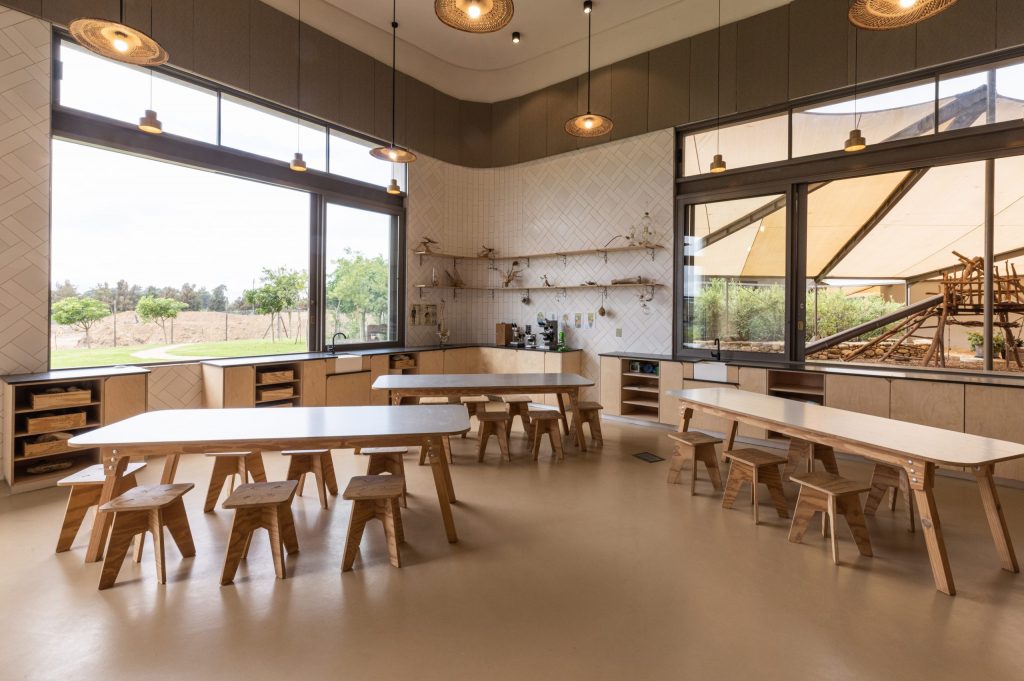
Photo: Green School South Africa
If I understand right, you apply a multidisciplinary approach? Do you house laboratories for these experiments and research?
Andrea: Absolutely correct. Students are interested in finding out whether river water is healthy. Which tools can be used to find out? They took water samples and sent them to the laboratory for results.
Our green kitchen is the laboratory because it’s also cooking and alternate scientific processes take place there since we do not burn chemicals or do traditional experiments.
Does this mean that in Green School a traditional laboratory can’t be used in terms of experiments…
Andrea: No. Because unlike a traditional laboratory, we cannot afford to dump the toxic chemicals and metals generated in experiments i.e. copper, magnesium and other hazardous chemicals. We practice a nature based empirical science involving fruit products and naturally produced chemicals.
You have also mentioned earlier the quest projects. What do they look like?
Andrea: Let me share an example with you. One of our Grade-8 students, from a year ago, did his quest research project on our medicinal herb garden. A lady who is a Rooibos specialist made herbal teas made from the herbs with specific effect i.e. for calming nerves, for flu etc. The underlying process of identifying, picking, smelling and brewing the tea was only possible due to access to the herbal garden.
Photo: Green School South Africa
It is a sprawling natural environment, something the children and their parents become aware of the moment they walk into our campus and that is how they like it to be; not a sterile environment. We educate the children to explore the environment including the various animals, without causing them anxiety.
At our school the breaks are longer: 45 minutes. The break is as long as a lesson since the kids need enough time for playing, developing social skills and eating together. The kids are aware of the utility of various things and if they are unsure, they ask the adults to make informed purchase decisions.
What amount of students per class do you have?
Andrea: There are twenty students in a class under the supervision of two teachers with a 1:10 teaching ratio. We have an experienced senior teacher assisted by a junior teacher fresh out of college. While the junior teachers who are on two years’ contracts are always a flow of fresh energy; they grab experience and pedagogic skills in our green school.
Photo: Green School South Africa
They can apply to stay with us; however, we encourage them to explore the world’s schooling system since they are young and we don’t want them to be trapped. Two of our founding junior teachers, inspired from sustainability, have moved into sustainability-aligned careers, outside of teaching. Moreover, we used our social media contacts to refer another teacher i.e. One of our junior teachers went to a school in Brazil for knowledge sharing on sustainability in the social sector.
July 2023
